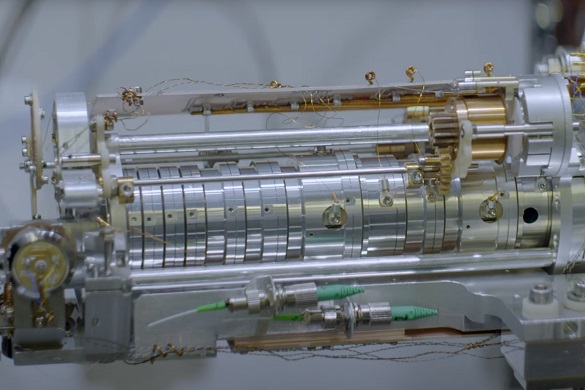
Photograph of the AEgIS antimatter trap [Credit: University of Liverpool
The AEgIS experiment at CERN has made a groundbreaking advancement by successfully demonstrating laser cooling of positronium (Ps), an exotic atom composed equally of matter and antimatter.
This significant development, published in a paper in Physical Review Letters,marks a pivotal moment in the exploration of the fundamental symmetries of the universe and involved several members of Liverpool’s QUASAR Group.
Positronium, a unique atom made of an electron and its antimatter counterpart, the positron, stands out due to the absence of a hadronic nucleus, allowing for extremely precise numerical calculations of quantum states and transitions.
The transient nature of positronium, with its constituents usually annihilating each other in few hundred nanoseconds, along with their high velocities, has traditionally posed a formidable challenge to scientists attempting to experimentally study its properties.
The recent breakthrough by the AEgIS collaboration, where the UK’s contribution is supported by the Engineering and Physical Sciences Research Council (EPSRC) and the Science and Technology Facilities Council (STFC), overcomes these challenges by employing broadband laser cooling. This technique, which involves the transfer of momentum from specifically tailored laser light to the positronium atoms, allows for the cooling of the entire positronium ensemble in the direction of the laser. This approach differs from more selective narrow-band Doppler cooling methods and represents a significant innovation in the field.
Dr Benjamin Rienäcker, newly-elected AEgIS Physics Coordinator and a member of the Liverpool QUASAR Group based at CERN, said: “The implications of this achievement extend beyond the technical success of laser cooling positronium. It paves the way for more accurate measurements, crucial for advancing our understanding of antimatter and its role in the universe. I expect this breakthrough to enable new experiments, offering fresh insights into the cosmic matter-antimatter imbalance and the fundamental building blocks of the universe.”
The successful laser cooling of positronium significantly enhances the AEgIS experiment’s efforts towards antihydrogen formation as well as opening up entirely new pathways for precision experiments in Quantum Electrodynamics and tests of the Equivalence Principle with positronium. Furthermore, it enables the formation of positronium beams and the exploration of Bose-Einstein condensates, expanding the scope for inertial tests and studies on macroscopic quantum objects.
Dr Ruggero Caravita, spokesperson for the AEgIS collaboration, has been awaiting this result for almost a full decade: “When I witnessed the first atomic excitation of positronium at AEgIS back in 2015, I knew we could be the ones to achieve this more than thirty years old dream of antimatter physicists. It has now become reality, thanks to the efforts of everybody involved.”
Professor Carsten P Welsch, who leads the University of Liverpool contribution to the AEgIS experiment, added: “By exploring the properties and behaviour of exotic atoms like positronium, we are advancing our knowledge of fundamental physics at the same time as opening doors to technological innovations with potentially much wider applications. This fantastic result is testament to the excellent teamwork and collaboration within AEgIS.”
Liverpool physicists have made important contributions to the antimatter physics community for many years: The QUASAR Group has pioneered a large number of detector and sensor innovations for low energy antiproton beams, and Liverpool initiated and coordinated the multi-million Euro Accelerators Validating Antimatter physics (AVA) research network – the largest-ever research and training network on low energy antimatter physics. The AEgIS breakthrough lays the foundation for an exciting physics programme ahead.
More information can be found in the full article.